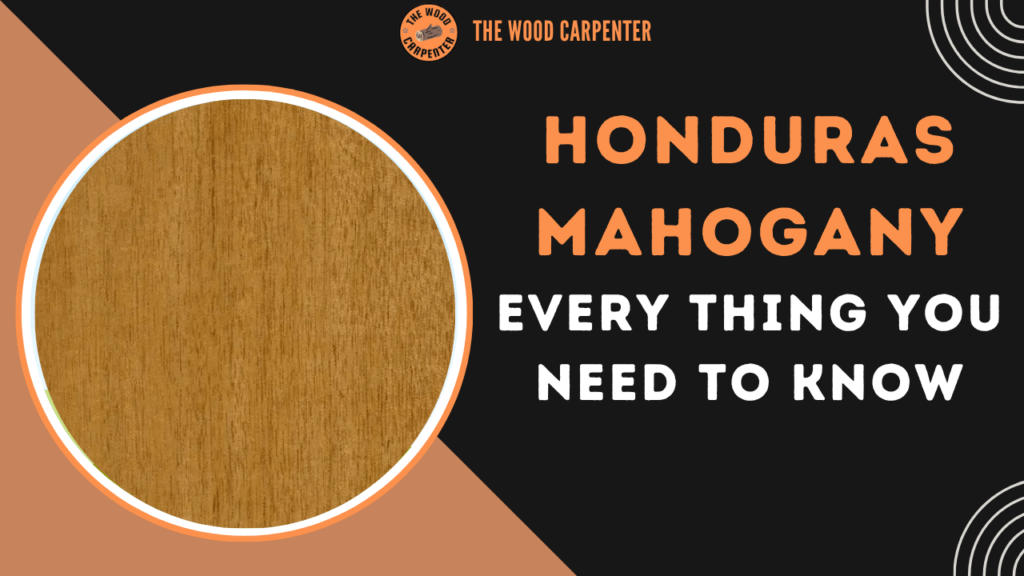
Introduction
Honduras Mahogany, or Honduran Mahogany, Genuine Mahogany, or Swietenia macrophylla, is one of the most highly regarded hardwoods in the world. This wood has been used for gorgeous furniture, musical instruments, and luxury interiors for hundreds of years because it is beautiful, strong, and versatile.
This in-depth article will cover the history, features, usage, and care of Honduras Mahogany wood, as well as answer some of the most prevalent concerns about this unique wood.
What is Honduras Mahogany?
The wood of the Swietenia macrophylla tree, which is native to Central and South America, is called Honduras Mahogany. It comes from southern Mexico, Central America, and South America. This is the most common and commercially important type of true mahogany. To set it apart from other woods sold as mahogany, it is often termed “Genuine Mahogany.”
Botanical Profile
| Attribute | Details |
| Scientific Name | Swietenia macrophylla |
| Common Names | Honduras Mahogany, Genuine Mahogany, American Mahogany, Big-Leaf Mahogany, Brazilian Mahogany |
| Family | Meliaceae |
| Native Range | Southern Mexico to Central and South America |
| Tree Size | Up to 150–200 feet tall, trunk diameter up to 6 feet |
Appearance and Physical Properties
Color and Grain
Heartwood Color: It can be pale pinkish brown to deep reddish brown, and it gets darker as it gets older and is exposed to light.
Grain: Usually straight, however it can also be wavy, interlaced, or uneven. People really like how the grain chatoyancy (a shimmering optical effect) looks.
Texture: Medium and even, with a slight natural shine.
Density and Hardness
Janka Hardness: About 900 lbf (4,020 N), which means it’s softer than most other tropical hardwoods but still highly strong.
Weight: Medium density; wood from older, wild-grown trees is heavier, denser, and more durable than wood from plantation-grown trees.
Durability
Rot Resistance: Depending on the tree’s age and the conditions in which it grows, it can be moderately or exceptionally durable. Heartwood is usually safe from termites, although other bugs can get to it.
Stability: Excellent dimensional stability; resists warping and shrinking, making it ideal for precision woodworking.
Workability
Honduras Mahogany is celebrated for its ease of work. It cuts, shapes, and sands smoothly, both by hand and with machine tools. It glues, stains, and finishes exceptionally well, resulting in a silky, lustrous surface. However, figured or irregular grain sections may be prone to tear-out if not handled carefully.
Machining and Finishing
Machining: Easy to saw, plane, and turn, but interlocked grain may require sharp tools and careful technique.
Sanding: Sands to a fine, smooth finish.
Finishing: Takes stains, varnishes, and polishes beautifully, enhancing its natural luster and depth.
Uses of Honduras Mahogany
The unique blend of beauty, stability, and durability makes Honduras Mahogany a top choice for a wide range of high-end applications:
Furniture: Classic and modern furniture, cabinets, and paneling.
Musical Instruments: Backs, sides, and necks of guitars, drum shells, and other instruments due to its warm tonal qualities.
Boatbuilding: Valued for its resistance to rot and moisture.
Architectural Woodwork: Doors, moldings, millwork, and luxury interiors.
Veneers: Used for decorative surfaces in furniture and interiors.
Carvings and Turned Objects: Ideal for intricate work due to its workability and fine grain.
Sustainability and Legal Considerations
Honduras Mahogany is listed under CITES Appendix II, meaning its international trade is regulated to prevent over-exploitation. Legal harvesting and export require proper documentation. Most available wood today comes from managed plantations rather than wild forests, which helps ensure sustainability.
Comparison: Honduras Mahogany vs. Other Mahogany
| Feature | Honduras Mahogany (S. macrophylla) | African Mahogany (Khaya spp.) | Cuban Mahogany (S. mahagoni) |
| True Mahogany? | Yes | No | Yes |
| Color | Reddish-brown, deepens with age | Lighter, less rich | Dark, rich brown |
| Workability | Excellent | Good | Excellent |
| Durability | Very durable | Moderately durable | Very durable |
| Availability | Plantation-grown, regulated | Widely available | Rare, limited |
| Price | Higher | Lower | Highest |
Also read:
Types of Mahogany Wood: A Complete Guide to Varieties, Uses & Prices
Caring for Honduras Mahogany
To avoid uneven darkening, keep it out of direct sunlight.
The wood is dimensionally stable, but you should keep the humidity consistent to prevent movement.
Don’t use strong chemicals; instead, use soft cleaners.
Polishing it every so often will keep it shiny and protect the surface.
Frequently Asked Questions (FAQ)
1. What makes Honduras Mahogany “genuine” mahogany?
Honduras Mahogany (Swietenia macrophylla) is called “genuine” because it is one of the three species in the Swietenia genus, which are the only real mahoganies. African and Philippine mahogany, for example, are not real mahoganies in the botanical sense.
2. Is Honduras Mahogany the same as other types of mahogany?
No, Honduras Mahogany is thought to be the best type of mahogany since it is unique and lasts a long time.
3. How does Honduras Mahogany compare to African Mahogany?
Honduras Mahogany is denser, lasts longer, and is generally thought to be better for work and looks. African Mahogany is cheaper and easier to find, but it isn’t real mahogany.
4. What are the most common uses for Honduras Mahogany?
Because it is beautiful, stable, and easy to work with, it is utilized in high-end furniture, musical instruments, boatbuilding, architectural woodwork, and ornamental veneers.
5. What does the wood look like?
The heartwood can be pale pinkish brown to deep reddish brown, and the grain can be straight, wavy, or interlaced. As it gets older and is exposed to light, its color gets darker and deeper.
6. Is Honduras Mahogany hard or soft?
It is a medium-hard wood with a Janka hardness of about 900 lbf (4,020 N). This makes it softer than a lot of tropical hardwoods, but it is still very strong and good for fine woodworking.
7. Does Honduras Mahogany have any special working properties?
Yes, it is known for being easy to work with, sanding smoothly, and finishing well. However, figured grain may need particular attention to keep from tearing out.
8. Is the wood resistant to pests and decay?
The heartwood is generally resistant to termites and rot, especially in older, wild-grown trees. Plantation-grown wood may be slightly less resistant but still performs well.
9. What makes Honduras Mahogany so costly?
Compared to other hardwoods, the price is higher since it is beautiful, strong, hard to find because of rules, and in great demand for luxury uses.
10. Is it okay to use Honduras Mahogany outside?
It won’t decay or get wet, but it’s preferable to use it outside where it won’t get wet or in protected areas to make it last longer.
Final Thoughts
Honduras Mahogany is the best kind of real mahogany since it is the most beautiful, easy to work with, and long-lasting. This wood has a long history and great features that make it a classic choice, whether you’re a carpenter, musician, or simply an admirer of fine materials. Always ensure your wood is sourced responsibly to help preserve this magnificent species for gener

